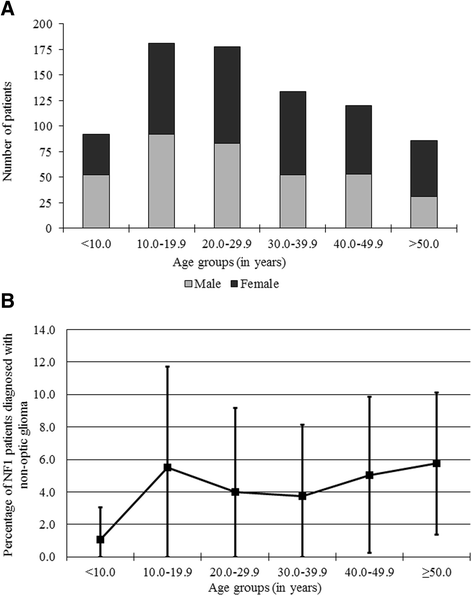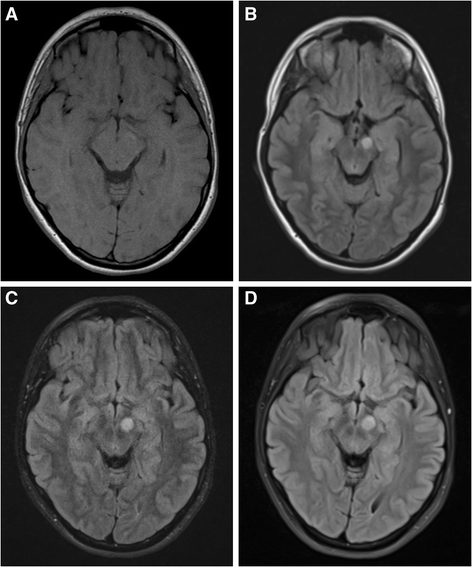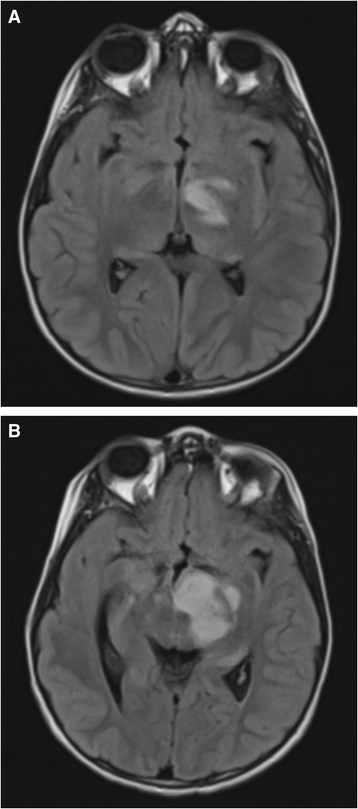Non-optic glioma in adults and children with neurofibromatosis 1
- PMID: 28202035
- PMCID: PMC5312522
- DOI: 10.1186/s13023-017-0588-2
Non-optic glioma in adults and children with neurofibromatosis 1
Abstract
Background: Non-optic gliomas occur in 5% of children with NF1, but little is known about these tumours in adults. We aimed to investigate progression, spontaneous regression and the natural history of non-optic gliomas in adults and compare these findings to the results found in children.
Results: One thousand seven hundred twenty-two brain MRI scans of 562 unselected individuals with NF1 were collected at the NF outpatient department of the University Hospital Hamburg-Eppendorf between 2003 and 2015. The number of scans per patient ranged from one to 12; patients were followed for a median of 3.7 years. We identified 24 patients (4.3%) with non-optic gliomas. Median age at first scan with glioma was 21.2 years, much higher than in previous publications. Only seven of the 24 non-optic glioma patients were symptomatic. Five of 24 patients had multiple non-optic gliomas. Four individuals developed a new tumour, and 4 cases showed progression. The risk of new tumour development was 0.19% (95% confidence interval 0.06% to 0.52%) per patient year of follow-up for patients over 10 years. The rate of progressing non-optic gliomas per patient year of follow-up in the first 5 years after tumour diagnosis was 4.7% (95% confidence interval 1.5% to 12%).
Conclusions: Non-optic gliomas are twice as common in an unselected cohort of NF1 patients as previously reported. This is likely due to increased frequency of diagnosis of asymptomatic tumours when routine MRIs are performed and a higher prevalence in older individuals.
Keywords: Adults; Children; Cohort study; Glioma; Neurofibromatosis 1; Prospective.
Figures



Similar articles
-
Neurofibromatosis type 1 and sporadic optic gliomas.Arch Dis Child. 2002 Jul;87(1):65-70. doi: 10.1136/adc.87.1.65. Arch Dis Child. 2002. PMID: 12089128 Free PMC article.
-
Clinical presentation and prognostic indicators in 100 adults and children with neurofibromatosis 1 associated non-optic pathway brain gliomas.J Neurooncol. 2017 Jul;133(3):609-614. doi: 10.1007/s11060-017-2475-z. Epub 2017 Jun 7. J Neurooncol. 2017. PMID: 28593402 Free PMC article.
-
Serial MRIs provide novel insight into natural history of optic pathway gliomas in patients with neurofibromatosis 1.Orphanet J Rare Dis. 2018 Apr 23;13(1):62. doi: 10.1186/s13023-018-0811-9. Orphanet J Rare Dis. 2018. PMID: 29685181 Free PMC article.
-
Optic Pathway Glioma and Cerebral Focal Abnormal Signal Intensity in Patients with Neurofibromatosis Type 1: Characteristics, Treatment Choices and Follow-up in 134 Affected Individuals and a Brief Review of the Literature.Anticancer Res. 2016 Aug;36(8):4095-121. Anticancer Res. 2016. PMID: 27466519 Review.
-
Gliomas in patients with neurofibromatosis type 1.Expert Rev Neurother. 2009 Apr;9(4):535-9. doi: 10.1586/ern.09.4. Expert Rev Neurother. 2009. PMID: 19344304 Review.
Cited by
-
Expanding the clinical phenotype of individuals with a 3-bp in-frame deletion of the NF1 gene (c.2970_2972del): an update of genotype-phenotype correlation.Genet Med. 2019 Apr;21(4):867-876. doi: 10.1038/s41436-018-0269-0. Epub 2018 Sep 7. Genet Med. 2019. PMID: 30190611 Free PMC article.
-
Increased prevalence of brain tumors classified as T2 hyperintensities in neurofibromatosis 1.Neurol Clin Pract. 2018 Aug;8(4):283-291. doi: 10.1212/CPJ.0000000000000494. Neurol Clin Pract. 2018. PMID: 30140579 Free PMC article.
-
Brain tumors in Neurofibromatosis type 1.Neurooncol Adv. 2019 Oct 26;1(1):vdz040. doi: 10.1093/noajnl/vdz040. eCollection 2019 May-Dec. Neurooncol Adv. 2019. PMID: 32642668 Free PMC article. Review.
-
A Systematic Review of Diagnostic Modalities and Strategies for the Assessment of Complications in Adult Patients with Neurofibromatosis Type 1.Cancers (Basel). 2024 Mar 11;16(6):1119. doi: 10.3390/cancers16061119. Cancers (Basel). 2024. PMID: 38539455 Free PMC article. Review.
-
The molecular landscape of glioma in patients with Neurofibromatosis 1.Nat Med. 2019 Jan;25(1):176-187. doi: 10.1038/s41591-018-0263-8. Epub 2018 Dec 10. Nat Med. 2019. PMID: 30531922 Free PMC article.
References
-
- Neurofibromatosis 1 [http://www.ncbi.nlm.nih.gov/books/NBK1109/]. Access date 14 Feb 2017.
-
- Evans GD, O’Hara C, Wilding A, Ingham SL, Howard E, Dawson J, Moran A, Scott-Kitching V, Holt F, Huson SM. Mortality in neurofibromatosis 1: in North West England: an assessment of actuarial survival in a region of the UK since 1989. Eur J Hum Genet. 2011;19:1187–91. doi: 10.1038/ejhg.2011.113. - DOI - PMC - PubMed
Publication types
MeSH terms
LinkOut - more resources
Full Text Sources
Other Literature Sources
Medical
Research Materials
Miscellaneous

